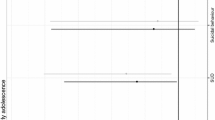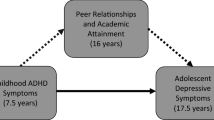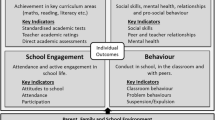Abstract
OBJECTIVES: A life course approach and linked Manitoba data from birth to age 18 were used to facilitate comparisons of two important outcomes: high school graduation and Attention-Deficit/Hyperactivity Disorder (ADHD). With a common set of variables, we sought to answer the following questions: Do the measures predicting high school graduation differ from those that predict ADHD? Which factors are most important? How well do the models fit each outcome?
METHODS: Administrative data from the Population Health Research Data Repository at the Manitoba Centre for Health Policy were used to conduct one of the strongest observational designs: multilevel modelling of large population (n = 62,739) and sibling (n = 29,444) samples. Variables included are neighbourhood characteristics, measures of family stability, and mental and physical health conditions in childhood and adolescence.
RESULTS: The adverse childhood experiences important for each outcome differ. While family instability and economic adversity more strongly affect failing to graduate from high school, adverse health events in childhood and early adolescence have a greater effect on late adolescent ADHD. The variables included in the model provided excellent accuracy and discrimination.
CONCLUSION: These results offer insights on the role of several family and social variables and can serve as the basis for reliable, valid prediction tools that can identify high-risk individuals. Applying such a tool at the population level would provide insight into the future burden of these outcomes in an entire region or nation and further quantify the burden of risk in the population.
Résumé
OBJECTIFS: Nous avons utilisé une approche axée sur le parcours de vie et maillé des données du Manitoba de la naissance à 18 ans pour faciliter les comparaisons de deux effets importants: l’obtention du diplôme d’études secondaires et le trouble déficitaire de l’attention avec hyperactivité (TDAH). Avec un jeu de variables commun, nous avons cherché à répondre aux questions suivantes: Les indicateurs prédisant l’obtention du diplôme d’études secondaires diffèrent-ils de ceux qui prédisent le TDAH? Quels facteurs sont les plus importants? Les modèles sont-ils bien adaptés à chaque résultat?
MÉTHODE: Les données administratives du Centre d’élaboration et d’évaluation de la politique des soins de santé, au Centre de la politique des soins de santé du Manitoba, ont servi à mener l’un des protocoles d’étude observationnelle les plus robustes: la modélisation multiniveau d’échantillons d’une grande population (n = 62 739) et de frères et sœurs (n = 29 444). Les variables incluses étaient les caractéristiques du quartier, des indicateurs de stabilité familiale, ainsi que les états de santé mentale et physique durant l’enfance et l’adolescence.
RÉSULTATS: Les expériences défavorables de l’enfance qui importent pour chaque effet sont différentes. L’instabilité familiale et l’adversité économique ont un effet plus prononcé sur l’abandon des études secondaires avant l’obtention du diplôme, tandis que les problèmes de santé durant l’enfance et au début de l’adolescence ont davantage d’effet sur le TDAH en fin d’adolescence. Les variables incluses dans le modèle ont apporté une précision et une discrimination excellentes.
CONCLUSION: Ces résultats éclairent le rôle de plusieurs variables familiales et sociales et peuvent servir à créer des outils de prédiction fiables et valides pouvant identifier les personnes à haut risque. L’application d’un tel outil à l’échelle d’une population donnerait une idée du fardeau futur de ces effets dans une région ou un pays et permettrait de chiffrer davantage le fardeau du risque dans la population.
Similar content being viewed by others
References
Hertzman C. Human development, life course, intervention and health. In: Pickles A, Maughan B, Wadsworth M (Eds.), Epidemiological Methods in Life Course Research. Oxford: Oxford University Press, 2007; 111–36.
Schoeni R, House J, Kaplan G, Pollack H (Eds.). Making Americans Healthier: Social and Economic Policy as Health Policy. New York, NY: Russell Sage Foundation, 2008.
Currie J, Stabile M. Child mental health and human capital accumulation: The case of ADHD. J Health Econ 2006;25(6):1094–118. PMID: 16730082. doi: 10.1016/j.jhealeco.2006.03.001.
Adler N, Stewart J. Health disparities across the lifespan: Meaning, methods, and mechanisms. Ann N Y Acad Sci 2010; 1186:5–23. PMID: 20201865. doi: 10.1111/j.1749-6632.2009.05337.x.
Currie J. Healthy, wealthy, and wise: Socioeconomic status, poor health in childhood, and human capital development. J Econ Lit 2000;41(1):87–122. doi: 10.1257/jel.47.1.87.
Koenen K, Rudenstine S, Susser E, Galea S (Eds.). A Life Course Approach to Mental Disorders. New York, NY: Oxford University Press, 2014.
Duncan G, Murnane R (Eds.). Whither Opportunity? New York, NY: Russell Sage Foundation, 2011.
Jutte D, Roos N, Brownell M, Briggs G, MacWilliam L, Roos L. The ripples of adolescent motherhood: Social, educational and medical outcomes for children of teen and prior teen moms. Acad Pediatr 2010;10(5):293–301. PMID: 20674531. doi: 10.1016/j.acap.2010.06.008.
Levine J, Pollack H, Comfort M. Academic and behavioral outcomes among the children of young mothers. J Marriage Fam 2001;63(2):355–69. doi: 10. 1111/j.1741-3737.2001.00355.x.
Lahey B, D’Onofrio B. All in the family: Comparing siblings to test causal hypotheses regarding environmental influences on behavior. Curr Dir Psychol Sci 2010;19(5):319–23. PMID: 23645975. doi: 10.1177/0963721410383977.
Oreopoulos P, Stabile M, Walld R, Roos L. Short, medium, and long term consequences of poor infant health: An analysis using siblings and twins. J Hum Resour 2008;43(1):88–138. doi: 10.3368/jhr.43.1.88.
Moffitt R. Remarks on the analysis of causal relationships in population research. Demography 2005;42(1):91–108. PMID: 15782897. doi: 10.1353/dem.2005.0006.
The Johns Hopkins ACG Case-Mix System (Version 6.0 Release Notes). Baltimore, MD: Johns Hopkins University, 2003
Martens PJ, Fransoo R, McKeen N, The Need to Know Team, Burland E, Jebamani L, et al. Patterns of Regional Mental Illness Disorder Diagnoses and Service Use in Manitoba: A Population-Based Study. Winnipeg, MB: Manitoba Centre for Health Policy, 2004.
Mann C. Observational research methods. Research design II: Cohort, cross sectional, and case-control studies. Emerg Med J 2003;20(1):54–60. PMID: 12533370. doi: 10.1136/emj.20.1.54.
Jaffee S, Strait L, Odgers C. From correlates to causes: Can quasi-experimental studies and statistical innovations bring us closer to identifying the causes of antisocial behavior? Psychol Bull 2012;138(2):272–95. PMID: 22023141. doi: 10.1037/a0026020.
Agnew-Blais J, Seidman L. Attention deficit/hyperactivity disorder over the life course. In: Koenen K, Rudenstine S, Susser E, Galea S (Eds.), A Life Course Approach to Mental Disorders. New York, NY: Oxford University Press, 2014; 156–64.
Turkheimer E, Waldron M. Nonshared environment: A theoretical, methodological, and quantitative review. Psychol Bull 2000;126(1):78–108. PMID: 10668351. doi: 10.1037/0033-2909.126.1.78.
Smith M. Multiple Comparisons. Available at: http://www.ma.utexas.edu/users/mks/384E07/multcomp.pdf (Accessed March 12, 2015).
Green K. Assessing Probabilistic Forecasts About Particular Situations. Melbourne, Australia: Business and Economics Forecasting Unit, 2004.
Hastie T, Tibshirani R, Friedman J. The Elements of Statistical Learning: Data Mining, Inference and Prediction. New York, NY: Springer Science + Business Media, Inc., 2001.
Powell B, Carr Steelman L. The educational benefits of being spaced out: Sibship density and educational progress. Am Sociol Rev 1993;58(3):367–81. doi: 10.2307/2095906.
Strully K, Mishra G. Theoretical underpinning for the use of sibling studies in life course epidemiology. In: Lawlor D, Mishra G (Eds.), Family Matters: Designing, Analyzing and Understanding Family Based Studies in Life Course Epidemiology. Oxford: Oxford University Press, 2009; 39–56.
Link BG, Phelan JC. Understanding sociodemographic differences in health — The role of fundamental social causes. Am J Public Health 1996;86(4):471–73. PMID: 8604773. doi: 10.2105/AJPH.86.4.471.
Rosella L, Manual D, Burchill C, Stukel T. A population based algorithm for the development of diabetes: Development and validation of the Diabetes Population Risk Tool (DPoRT). J Epidemiol Community Health 2011; 65(7):613–20. PMID: 20515896. doi: 10.1136/jech.2009.102244.
Author information
Authors and Affiliations
Corresponding author
Additional information
Disclaimer: The results and conclusions are those of the authors and no official endorsement by the Manitoba Centre for Health Policy, Manitoba Health, or other data providers is intended or should be inferred.
Acknowledgements: This research has been supported by the Social Sciences and Humanities Research Council, the Canadian Institutes of Health Research, and the Canadian Institute for Advanced Research. Data used in this study are from the Population Health Research Data Repository housed at the Manitoba Centre for Health Policy, University of Manitoba and were derived from data provided by Manitoba Health and Manitoba Education under project #2007/2008-22 and project #2007/2008-20C.
Conflict of Interest: None to declare.
Rights and permissions
About this article
Cite this article
Wall-Wieler, E., Roos, L.L., Chateau, D.G. et al. What predictors matter: Risk factors for late adolescent outcomes. Can J Public Health 107, e16–e22 (2016). https://doi.org/10.17269/cjph.107.5156
Received:
Accepted:
Published:
Issue Date:
DOI: https://doi.org/10.17269/cjph.107.5156




